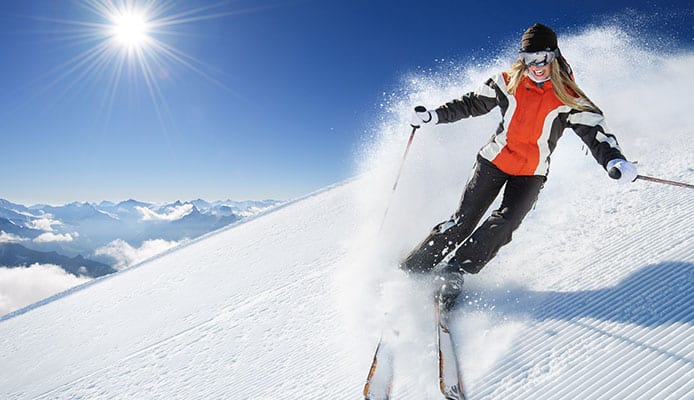
-
1.
-
2.
-
3.
-
4.
-
5.
Boots are one of the most important pieces of your ski equipment, largely responsible for how you feel on the snow. An ill-fitted boot can turn your day into torture, and female skiers are particularly aware of this. Because women have anatomically different feet, the boot design needs to follow. This is why the best women ski boots are designed to give optimal performance and comfort while catering to the needs of women skiers.
The design differences we’re talking about are the boot flex, cuff height, fit, and many others. For this reason, we’ve created a buying guide where we break down and explain all of these. Buying a new pair of boots is an important decision for every skier, and being prepared and informed makes things a lot easier. Before we jump into the guide, take a look at our selection of fantastic ski boots women enjoy around the world.
OUR TOP PICK
Apex HP-L All-Mountain Women
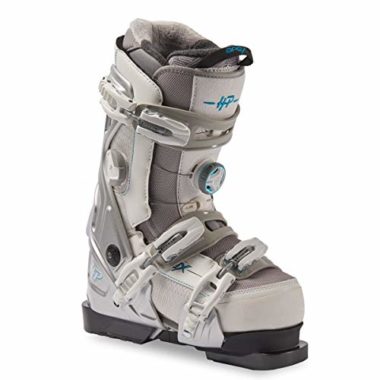
- Stand Out Features - Why We Love It
- Adjustable flex level
- Liner can be heat-molded
- BOA closure system
- Four lean positions
- External tongue construction
- Cuff alignment is adjustable
Flex: 75/85/95
Last: 99 to 103mm
Volume: Medium
Buckles: 3 (+ BOA closure system)
Mondo sizes: 23 to 27
Skill: Intermediate/Advanced
EDITORS CHOICE
SALOMON Quest Pro Women
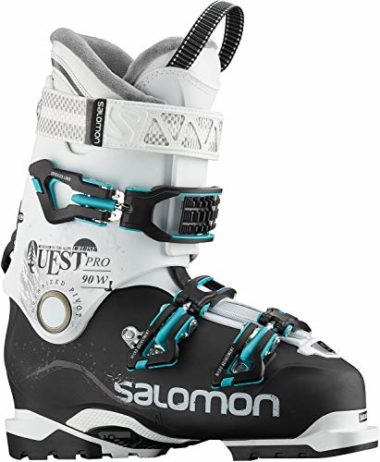
- Stand Out Features - Why We Love It
- Shell and liner can be heat-molded and customized
- CustomFit 3D liner with improved heel hold
- Women-specific liner design with more foam and fur
- Endofit tongue design for a better fit
- Sensifit shell with reinforced high-stress areas
Flex: 90
Last: 100mm
Volume: Medium
Buckles: 3, with micro-adjustment
Mondo sizes: 23 to 27.5
Skill: Intermediate/Advanced
BEST VALUE
Rossignol Alltrack 70 Women
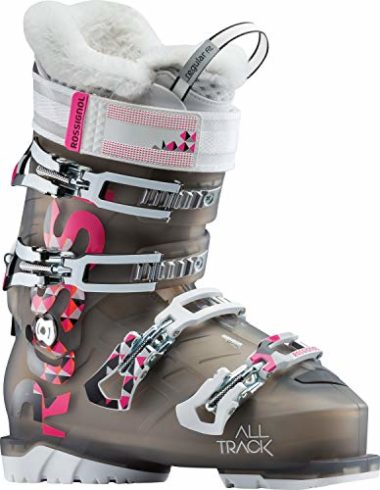
- Stand Out Features - Why We Love It
- Women-specific low cuff design
- Diagonal buckles for a better fit
- OptiSensor T4 contoured boot lining
- Hike mode is available
- Lightweight and very comfortable
Flex: 70
Last: 102mm
Volume: Medium
Buckles: 4, with micro-adjustment
Weight: 1880g (per boot)
Mondo sizes: 24.5 to 25.5
Skill: Beginner/Intermediate
SALOMON X Pro 70 Women
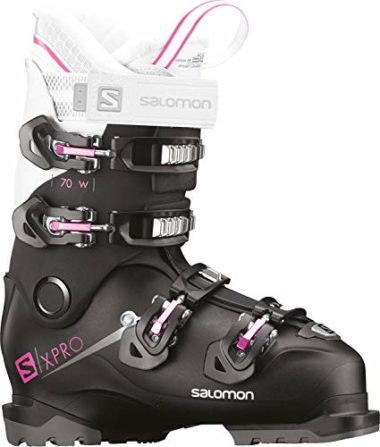
- Stand Out Features - Why We Love It
- TwinFrame design with rigid and softer spots
- Oversized pivot for improved boot precision
- Upper cuff is adjustable
- 3D customizable liner
- Replaceable toe and heel pads
Flex: 70
Last: 100mm
Volume: Medium
Buckles: 4, with micro-adjustment
Weight: 1905g (per boot)
Mondo sizes: 22.5 to 24.5
Skill: Beginner/Intermediate
Rossignol Pure Comfort 60 Women
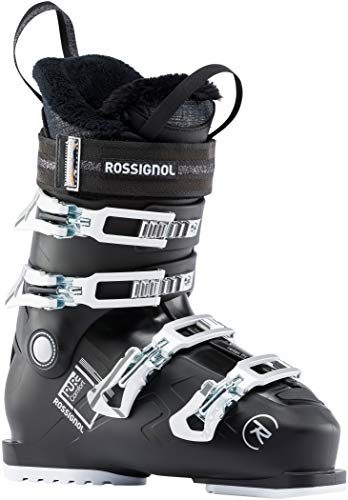
- Stand Out Features - Why We Love It
- Increased last width for wider feet
- Softer instep makes putting the boot on easier
- Tough aluminum buckles are easily adjustable
- Wider power strap for a more snug fit
- Soft flex is excellent for beginners
Flex: 60
Last: 104mm
Volume: High
Buckles: 4, with micro-adjustment
Mondo sizes: 22.5 to 27.5
Skill: Beginner/Intermediate
Tecnica Ten.2 65 CA W Women
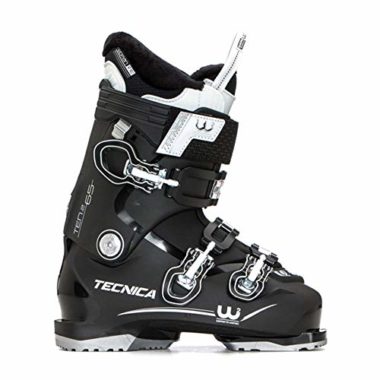
- Stand Out Features - Why We Love It
- Ultra-fit liner with Merino toe box
- Soft instep makes the foot slide in
- I-rebound system gives progressive forward flexing
- High volume boot feels comfy and warm
- Cuff adapt system for finding the best fit
Flex: 65
Last: 102mm
Volume: High
Buckles: 3
Mondo sizes:
Skill: Beginner
SALOMON X Pro 80 Custom Heat Connect Women
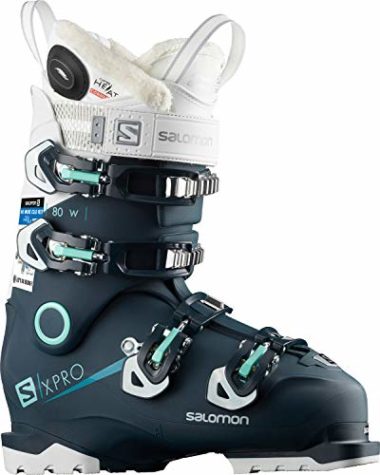
- Stand Out Features - Why We Love It
- Boot warmers are pre-installed
- TwinFrame reinforced shell design
- Last expands up to 106 millimeters
- Customizable 3D women-specific boot liner
- Oversized pivot for an improved power transfer
Flex: 80
Last: 100mm (expands to 106mm)
Volume: Medium
Buckles: 4, with micro-adjustment
Weight: 3920g
Mondo sizes: 24.5, 25.5
Skill: Intermediate
Dalbello DS MX 65 Women
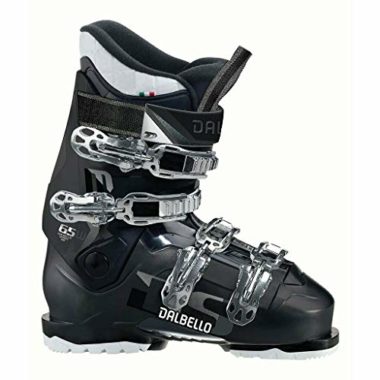
- Stand Out Features - Why We Love It
- Contour 4 system for increased comfort
- GripWalk option for easier hiking
- Wide last and boot volume
- Excellent beginner’s boot
- Incredibly lightweight and cozy
Flex: 65
Last: 105mm
Volume: High
Buckles: 4, with micro-adjustment
Mondo sizes: 23 to 27.5
Skill: Beginner
Nordica Sportmachine 65 W Women
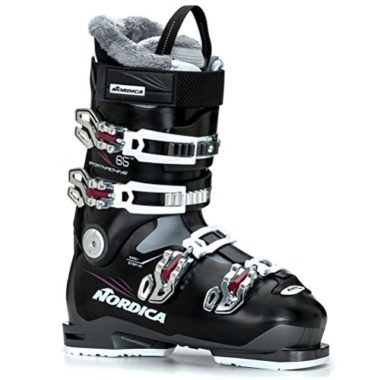
- Stand Out Features - Why We Love It
- Tri-Force shell construction with reinforcements
- Cuff profile can be precisely adjusted
- Dual Easy Entry instep makes the foot get in easily
- High volume and soft flex for a higher comfort
- Aluminum buckles are micro-adjustable
Flex: 65
Last: 102mm
Volume: High
Buckles: 4, with micro-adjustment
Mondo sizes: 26, 26.5
Skill: Beginner/Intermediate
Tecnica Mach1 105 LV Women
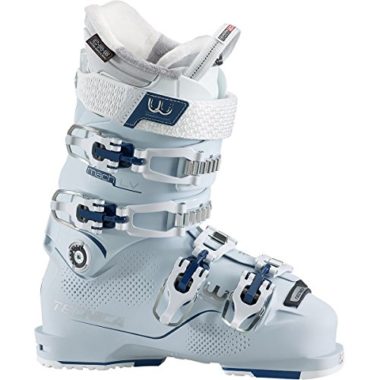
- Stand Out Features - Why We Love It
- C.A.S. technology makes customization easier
- Low inner boot volume for better precision
- Firm boot ideal for expert skiers
- Lambswool and Celliant liner increases warmth
- Asymmetrical shell design gives more power
Flex: 105
Last: 98mm
Volume: Low
Buckles: 4, with micro-adjustment
Weight: 1900g (per boot)
Mondo sizes: 22.5 to 26.5
Skill: Advanced/Expert
How To Choose Women Ski Boots – Buying Guide
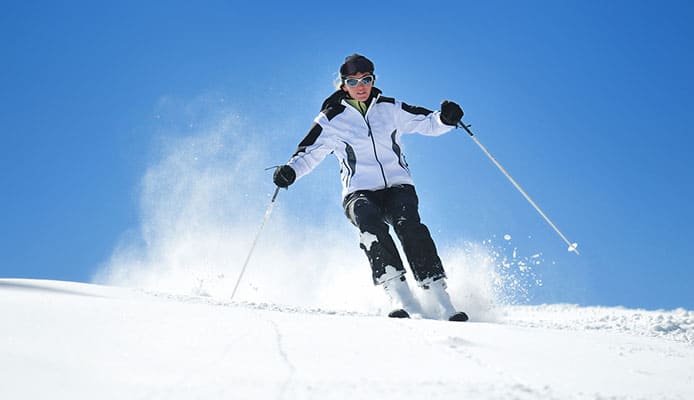
Whether you’re a beginner or a pro, finding the right ski boot is very important. We advise that you get a boot according to your skill level, so you can fully enjoy the time you spend on the snow. In addition to size and fit, you need to consider factors like flex, last, adjustability, and additional features. Take a look.
Type and Construction
All of the boots featured in our women ski boots reviews are alpine (all-mountain) ski boots. These are used in combination with alpine skis for downhill skiing, and both heel and toes are locked at all times. This type of boot can do almost anything you want it to, ready to conquer both groomed and ungroomed snow.
Other types of ski boots include telemark, alpine touring, and cross country boots (all designed for different types of skiing). As for the construction, most women’s boots use the overlap design, where the boot consists of a lower shell and upper cuff with a tongue inside. However, some skiers prefer the 3-piece Cabrio design, where a firm plastic tongue is located on the outer surface of the boot.
Related Review: Cross Country Ski Boots
Flex
When you lean in and press on the boot with your body weight, the boot flexes to a degree. This flex allows you to put power into your skis and control their movement. Depending on the model, ski boot flex ranges from soft to very firm. Because women weigh less than men, a women’s ski boot needs to have a softer flex. In addition, your skill plays a significant role when selecting the boot flex.
A soft boot transfers less power to the ski, which is why it’s very common in womens beginner ski boots. With a flex ranging from 40-60 (women’s models), these are great for people who are learning how to ski. They provide more comfort and tolerate the mistakes you make while perfecting your technique.
On the other hand, a firm boot gives you improved precision and control, making your foot feel like one with the ski. You’ll get a much better response from the ski, but beginners will find this type difficult to control. Firm boots have a flex ranging from 80-100 (advanced female skiers) to over 100 (expert skiers and racers). A medium flex boot (60-80) is common in womens intermediate ski boots. It’s able to give you a decent comfort level while also handling the ski well.
It’s worth noting that the flex rating isn’t universal, meaning that it differs from one manufacturer to another. For example, two boots with a flex 80 from different manufacturers often won’t feel the same. However, the flex rating is good to give you a general idea and can be used to compare different models from the same manufacturer.
Fit
Finding the right fit is probably the most important thing when selecting a boot. Because of the shape of a female foot, you need to pay close attention here. Even though many women have wide feet (in the forefoot area), ankles and heels are often narrower compared to men. This is why both the shell and the liner are designed differently in these areas.
Related Review: Ski Boots For Wide Feet
One of the big differences between men’s and women’s models is the cuff. Women have shorter legs and, because of this, the calf muscle sits lower on the leg. This is why the cuff is shorter and wider on female boots. A good fit in the cuff area is important, so a boot with micro-adjustable buckles and a good power strap will feel great.
When you put on the boot, it should feel snug around your foot (but not too tight). Also, it’s better if you’re wearing ski socks when trying it on because these socks are thinner and help preserve the liner. Keep in mind that the liner will compress a bit over time, so the boot will begin to feel looser. To find the perfect fit, many of the best women ski boots come with customizable shells and liners. Bootfitters heat up these parts and adapt them to follow the lines of your foot.
While some women skiers get tempted to buy kids’ ski boots, we would advise against doing this. A child’s leg is narrower and smaller, so the fit won’t be right. Also, kids’ boots have a much lower cuff and softer flex, meaning that you won’t be able to transfer power to the skis properly.
Related Review: Ski Boots For Narrow Feet & Ski Boots For Kids
Size
All ski boots use the Mondopoint system for sizing. This system is based on the foot length in centimeters, presented in half increments (for example 25, 25.5, etc). As we’ve mentioned in the previous paragraph, the boot should be snug but not press on the foot. Your toes are allowed to touch the lining but without a contact that is too strong.
It’s worth knowing that there is no difference in shell size when comparing sizes 25 and 25.5 (26 and 26.5 etc). The main difference between half sizes is in the liner or the insole. So, if the boot is too large or small, you’ll often have to jump a full size (26.5 to 25.5). The shell size (length) is also important to consider when choosing the ski bindings. If you need additional help with sizing, be sure to check out our ski boot size chart.
Last (Width)
The last is the width of your forefoot and it’s very important for comfort. You’ll find significant differences between models, which is great because it allows every female skier to find what they are looking for. The last on ski boots for narrow feet ranges from 93 to 98mm, from 98 to 102mm on medium, and from 102mm and up on ski boots for wide feet.
Finding the best ski boots for women (in terms of width) depends on own foot dimensions, so be sure to measure properly before ordering. In addition to this, we also want to mention the boot volume (the combination of forefoot width and instep height). A higher-volume boot will feel more comfortable and better for beginners, while a lower volume boot is more precise and responsive.
Comfort and Warmth
Even though many skiers don’t choose their ski boots solely based on comfort, it still plays an important role in our final decision. You’ll be glad to hear that female boots put a great accent on comfort. The best women ski boots on the market have thick liners and more padding in strategic areas, so you can endure wearing them throughout the season.
In addition, a thicker liner also means the boot is warmer. Some models also come with fur inserts to help keep your feet warmer. Other boots (like the SALOMON X Pro 80 Heat Connect) take things to an even higher level by integrating boot warmers into the liner.
On the other hand, a boot that is too loose will suffer in terms of performance. It’s not always smart to sacrifice performance for comfort, so you should try to find a balance between the two. Also, the liner will compress as you break in your ski boots, so you’ll get an additional bit of comfort that way.
Performance
As you know, the boot is responsible for transferring power to the skis and controlling their movement. The performance you’re aiming for has less to do with gender and more to do with your ability as a skier. Beginner skiers choose softer boots that give them more room for mistakes. On the other hand, advanced skiers choose firm and snug boots because they offer better control at higher speeds.
In combination with the women’s skis and the bindings, female boots have an increased ramp angle (compared to men’s models). This is done to improve the balance and power transfer because women have a lower center of gravity compared to male skiers.
You might also be interested in:
Additional Features
A good set of extra features on women’s ski boots will make you feel like the boot was made just for you. The things we particularly like are heat-forming liners and (or) shells, making it possible for the boot to adapt precisely to your foot shape. Be sure to consider this when choosing your ski boots, it will significantly improve comfort.
Most of the models on our list come with a power strap, used to create a tight fit around the cuff. It gives you improved control and reduces shin-bang on the firm shell. It’s also a big plus when the buckles can be finely tuned (using a screw to tighten or loosen them). Some models even come with flex adjustment, allowing you to make them softer or firmer.
A number of models offer cuff alignment too. Many women have a knock-kneed stance and this feature allows them to change the cuff angle so it’s in line with the natural direction of the leg. Finally, we want to mention that some models have a “walk” mode. They have a small lever that unlocks the cuff from the bottom, allowing your ankle to move when walking.
Durability
A great thing about ski boots is that they are generally pretty durable. Still, how long the boots last is determined by the plastic used for the shell as well as the frequency of use. Depending on these two factors, you can count on your ski boots to last anywhere from 2 to 10 years.
Furthermore, some parts of the boot wear out faster than others. For example, the lugs (tip and heel) can become damaged from constantly getting them in and out from the bindings. Some models allow you to replace these parts so you can use the boot for a longer time.
Most manufacturers give a 1-year warranty on womens all mountain ski boots. However, you’ll also come across models that offer 2 or more years of warranty. This can be worth noting because it shows you that the manufacturer believes in the quality of their product.
FAQs
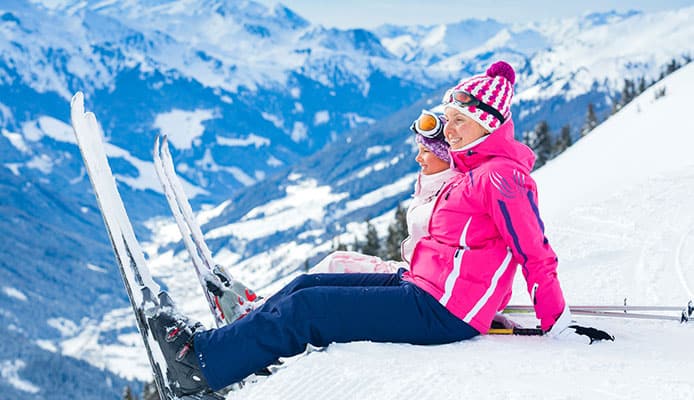
Q: What Is The Difference Between Men’s And Women’s Ski Boots?
The main differences between them is in the design. Women’s models have a lower and wider cuff, a softer flex, and a narrower fit at the heel and ankle. Also, the best ski boots for women come with thicker and warmer liners to increase comfort.
Q: How To Dry Ski Boots?
For day to day use during the ski season, a ski boot dryer can do a wonderful job. It works on a timed cycle and blows air into the boot. If your boots are soaked or you don’t want a dryer, then you have to take out the boot liner. Let the liner air dry, and take out the footbed from the shell. Dry the inside of the shell with a cloth and reassemble everything when it’s dry.
Avoid drying the boots with a hairdryer or close to a fire because it might deform the liner or the shell. If you want to learn more, be sure to read out article on drying ski and snowboard boots.
Related Post: How To Dry Ski BootsQ: How To Size Ski Boots?
Ski boots use the Mondo scale (the length of your foot). You should measure the length between the tip of your heel and the longest toe and round the result to the nearest half size. When putting on the ski boot, it should be tighter than a regular shoe. The exact size that you should get depends on your skill level too. For example, a beginner should get a boot that is slightly longer, while an advanced user usually gets a boot that is firmer and slightly shorter.
Globo Surf Overview
A great pair of boots will change the way you experience skiing. While the price tag on these might seem like much, they are definitely worth investing in. Like other women-specific gear (jackets, gloves, or pants), ski boots for women are made for the female body and give optimal performance. We hope our product selection and buying guide have made your choice a bit easier. Have fun skiing!
More Snow Ski Gear Reviews:
- Ski Bindings
- Ski Glove Liners
- Ski Knee Braces
- Ski & Snowboard Backpacks
- Ski Hats
- Ski Goggles
- Ski Poles
- Ski Helmets
- Women’s Ski Jackets
- Ski Gloves
- All Mountain Skis
- Womens Ski Gloves

